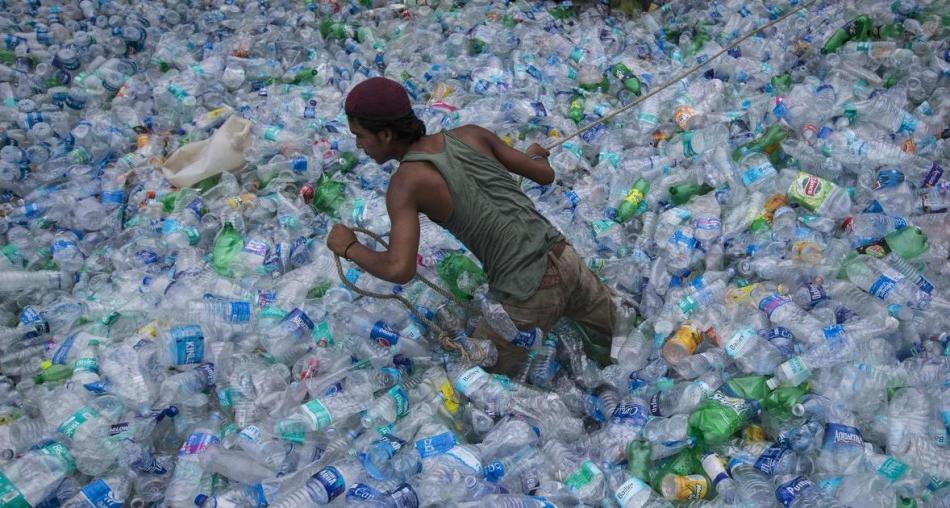Sagarika Mishra
The short-run economic benefits of plastic use are visibly great! This versatile, lightweight, cost-effective, and incredibly convenient material has substantially improved human living conditions and facilitated economic growth. Plastic has no close substitutes that have identical utility along with environment-friendly properties. Subsequently, its overproduction and unsustainable consumption have pushed environmental pollution exponentially. Its ubiquitous presence has led to the man-made calamity of mounting marine litter, ocean garbage patches and massive landfills. Due to the existing throwaway culture, animals in water and on land are now commonly found with plastics chocked in their stomach and drains are seen clogged in cities and municipalities. Given its non-biodegradable nature, plastic footprint will stay with us perpetually. Unless acted upon, it can only be accumulated, creating numerous issues in the long run.
So far, the world has produced 8.3 billion tonnes of plastics, and now it produces 300 million tonnes of plastic waste every year. Out of total plastic waste generated so far, only 10% and 14% are recycled and incinerated respectively. Eventually, the remaining is either dumped in the ocean or landfills or littered in the natural environment. According to a Central Pollution Control Board (CPCB) report, India produces 3.5 million tonnes of annual plastic waste. Compared to China (61 million tonnes) and the US (34.5 million tonnes), though plastic waste generation in India is much less, it still needs urgent attention because India appears to be poor at managing plastic waste. India’s waste has doubled in the last five years and will continue to grow extensively with increasing plastic demand due to rising population, income, and economic activities. Unless managed well, oceans would receive 23-37 million tonnes of plastic waste a year by 2040, where India’s contribution could be significant.
India’s population is expected to reach 1.5 billion by 2030 and 1.64 billion by 2050. India’s food grain production is expected to jump up to 345 MT by 2030 (from 303 MT now) and by 2050, food sufficiency would mean doubling our food productivity. But climate change, if not controlled, may reduce agricultural productivity of India by 25% by the end of this century and water stress may exaggerate it further. To monitor and regulate all such factors that could lead to low farm output, plasticulture under precision farming is contemplated by experts as the best practice to follow. It means more use of plastic in farm activities like making greenhouses, mulching to cover crop roots, providing shades and also for micro-irrigation. Though plasticulture guarantees increased output, reduces pesticide use, retains soil moisture, and saves water it is quite harmful for soil health. Again, it may further degrade environment if plastic waste is not managed well. Thus, farmers need to be well trained and sensitised enough regarding the potential environmental loss before adopting this practice.
More than 30 different primary plastics with various additives are used worldwide. When disposed of, these plastics leach thousands of toxic chemicals into soil andwater. Now microplasticis entering our food chain and is invariably reaching all of us through the water we drink or food we eat. The finding of an average person ingesting up to 5 grams of plastic could be a conservative estimation. The worst part is we have not been able to concretise the ill-effects of microplastic and plastic contaminated consumption on human health. But the harmful effects on the marine ecosystem are evident from the higher mortality of sea animals ingesting plastics. Similarly, materials commonly used in plastic containers are found associated with cell malfunctions, heart diseases and cancer. With the increasing global burden of diseases and increasing plastic consumption, their strong correlation may not be completely ruled out. Considering such loss to the environment and human health, plastic costs us infinitely in real and nominal terms.
So, we must make a circular economy possible for all plastics that we produce from the cradle to the grave. India recycles 60% of its plastic production, but the rest’s mismanagement has enormous ramifications for this densely populated country.
Increasingly the world is focusing on banning single-use plastic (SUP). India has hosted 2018 World Environment Day with the theme ‘Beat Plastic Pollution’ and is now heading towards an ambitious target of banning SUP by 2022. Banning SUP means India must halve its plastic production as SUP consists of almost 50% of the country’s total plastic production. However, it is surprising that this agenda is neither understood nor accepted at the grassroots, mainly because people don’t have substitutes. Alongside, plastic items are not labelled to reflect their limited or permitted usability and this effectively discourages people to respond to this policy initiative. Making rules and adhering to them with stricter enforcement may help reduce avoidable plastic waste in everyday use.
Relying on technological innovations to solve this problem of burgeoning plastic waste and leading economic growth beyond the planetary boundaries may not be sustained for long. Developing awareness about responsible consumption and production activities and sensitising one to adapt to lifestyles in harmony with nature may help us have a sustainable economy in future. Recent research says extending education may help to reduce the annual amount of inadequately managed plastic waste by 34%. Stricter regulations enforcing environmental norms would supplement further.
Since India’s poor plastic waste management is a global problem, better waste management is urgently solicited. It needs effective waste targeting and well-coordinated actions from consumers, producers, and policymakers in India and worldwide.
The writer is an assistant professor in the School of Rural Management at XIM University, Bhubaneswar.
